With National Minority Health Month quickly approaching, a local organization confronts the Black infant mortality rate—a decades old problem—by empowering one college-educated woman at a time. Click here to read more.
Loss Of Child Care Affects South LA
Although President Barack Obama’s announcement of across-the-board sequester cuts just recently sparked controversy. But low-income families in Los Angeles have been feeling the reverberation of federal and statewide budget cuts since 2008. In the past few years, Los Angeles County has lost 22,000 licensed child care slots.
According to a recent study by the Advancement Project, a policy change organization headed by Los Angeles activists Molly Munger and Connie Rice, just a 10 percent funding cut would eliminate an additional 59 percent of child care seats currently available for low-income families.
This lack of affordable and trustworthy child care can affect families in multiple ways. Parents who cannot work feel the most immediate impact. Young parents unable to acquire the proper skills to improve their job prospects also suffer, according to Jacquelyn McCroskey, professor in child welfare at the University of Southern California. McCroskey has dedicated over two decades to improving outcomes for families and children in Los Angeles County.
Crystal Stairs, a nonprofit organization, also hopes to help the families affected. The organization started 30 years ago with two mothers who wanted to improve the lives of families in Los Angeles. The nonprofit is part of an advocacy project called Community Voices that includes other child care service providers such as Pathways, Advancement Project and First 5 LA.
“In the area that we serve, there is multi-generational poverty,” said Jackie Majors, CEO. “We want to provide services so they can end the poverty cycle.”
Majors’ career in child care services spans 25 years, but most of the work was in the private sector, providing services to mainly affluent families.
“Although I loved what I did for 17 years, I really think that was all about preparing me for this work,” said Majors. “Those families were going to make it no matter what I did. The families that I serve now don’t have any other resources besides us.”
Majors said her greatest satisfaction comes from receiving a letter from a family saying that with a better paying job, they no longer qualify for Crystal Stairs’ services.
In addition to the immediate impact on parents, there are often more long-term consequences for children when there is a lack of child care services.
“It also has impact on the potential for children to be as ready for school as they could be,” said McCroskey. “They won’t be able to practice early learning skills and enhance their cognitive abilities.”
These negative consequences disproportionately affect low-income families. On average, each zip code in Los Angeles lost 170 child care seats beginning in 2008. However, many zip codes in South Los Angeles and Compton lost more than 300 licensed seats each.
When Majors became CEO of Crystal Stairs two years ago, budget cuts forced her to terminate 3,000 contracts for families. However, one of Majors’ goals as CEO includes diversifying the organization’s funding to better serve families. The organization has an annual fundraiser and strives for more outside funding.
Despite budget cuts, this summer Crystal Stairs added more child care services for residents in Compton and South L.A. Although this may seem like a step in the right direction, Majors does not rejoice in this success. She believes Crystal Stairs’ expansion is an indicator of the failure of other child care service providers.
Majors and McCroskey encourage child care service providers to unite rather than view each other as competition and act territorially.
McCroskey hopes that advocates, families and child care service providers can be more organized to fight back against state or federally proposed budget cuts.
OPINION: Meet Compton’s mayoral candidate Aja Brown
By Melissa Hebert
Aja Brown is a second-generation resident of Compton who has entered the municipal elections for Mayor of the City of Compton. Brown has an extensive background in planning and has experience working for Compton’s redevelopment agency.
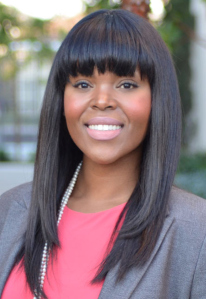 Aja Brown
Aja BrownPlease state your name and time as a resident in the City of Compton, and which district you reside in?
Aja Brown, second-generation Compton resident. I reside in District 2.
What makes you qualified to run for the seat you wish to fill?
I have over 10 years of community development and economic development experience working with the municipalities of Gardena, Inglewood, Pasadena (former Planning Commissioner) and the City of Compton’s redevelopment agency. I am an urban planner by educational training. I graduated from the University of Southern California’s Sol Price School of Public Policy, Planning and Development, and hold a B.S. in Policy, Planning and Development and a Master’s in Planning – emphasis Economic Development. [Read more…]
Los Angeles Urban League to survey South LA residents
In anticipation of the May 2013 city elections, the Los Angeles Urban League plans to send out volunteers across South Los Angeles on Saturday, March 23 to identify priorities in the community. The LAUL hopes to deploy 100 volunteers to survey 2,500 residents about what matters to them and present the results to elected officials.
Only two out of every ten eligible Los Angeles voters participated in the recent mayoral election, and less than 10% were African American or Latino. The Los Angeles Urban League says it hopes that by “igniting a movement that calls for greater civic engagement, the community can ensure that there is equity in education, economic development, public safety, and public health and housing opportunities for all residents of Los Angeles.”
Some of the survey locations will be:
o Baldwin Hill Crenshaw Plaza, 3650 MLK Blvd., 90008
o Ralph’s Supermarket, 3670 Crenshaw Blvd., 90008
o Starbucks, 3722 Crenshaw Blvd., 90016
The effort will kick off at 8 am March 23 at the LAUL’s headquarters, 3450 Mount Vernon Drive, Los Angeles, CA 90008.
A piece of wisdom off Slauson Avenue
By Daniella Segura
“Greetings friend,” said Mr. Wisdom, as a customer came through the door.
“Hey Mr. Wisdom, my brother! How are you today?,” said Perry Payton.
“Oh, I’m just trying to be as good as you,” said Mr. Wisdom, with a broad smile.
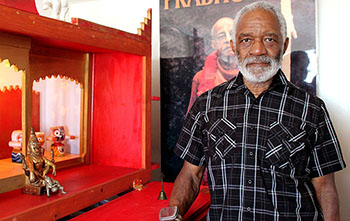 Mr. Wisdom
Mr. WisdomFor the past 25 years, the Jamaican native, who goes by the name Mr. Wisdom, has been serving specialty vegan food in South Los Angeles within the Hyde Park community, urging native residents to eat health and try his diet and cleanses.
“Some people, they call me Doctor Wisdom after I help them get healthier, and I have to correct them,” said Mr. Wisdom. “I am not a medicinal doctor. I am more like a nutritionist.”
The man who runs Mr. Wisdom’s Specialty Health Food Store refuses to reveal his real name, and is known to his customers by the shop’s moniker.
He started his business to promote, Hare Krishna, the common name for the International Society of Krishna Consciousness movement that is based in Hinduism.
He calls his business “Mr. Wisdom” in reference to Krishna, the god of the Hare Krishna religion, and said that Krishna is the real “Mr. Wisdom.”
Those who follow the Hare Krishna religion are strict vegans who do not eat meat or dairy products.
“In Hare Krishna, you realize animals are conscious,” said Mr. Wisdom. “They feel pain like you and I. In my religion, it is against the law of nature to cause pain or suffering to any living creature.”
Raised in Jamaica, Mr. Wisdom joined the British Army when he was 18. At the time, Jamaica was still an English colony.
“I wanted to find out what made the world tick,” he said.
After spending six years in the British Army, Mr. Wisdom stayed in England to get into the entertainment business because he wanted to “sing, dance and perform.”
In spite of his efforts, he never reached his dream, saying that the business was too competitive. So, he moved back to Jamaica and lived there for the next three years.
Still on the quest for success and adventure, Mr. Wisdom moved to the U.S. in the 1970s. After struggling to manage a gas station for a few years, he began searching for answers.
“I wanted to know why some people were so successful and other people, who were as equally talented, were not successful,” he said.
He looked to self-help books and different religions, but eventually found his answer in Hare Krishna, which he has followed for over the past 40 years.
Mr. Wisdom explained that after finding Hare Krishna, he wanted to do something for the community by selling healthier food and spreading the word about his religion. Yet, he did not have a place to do it. Instead, he sold items like wheatgrass from the back of a travel trailer, which also served as his home.
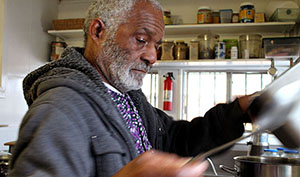 One day a sick woman came to him for help, Mr. Wisdom said. He helped her improve her diet, which then improved her health. Once she recovered, she came back to Mr. Wisdom to ask what she could to do repay him.
One day a sick woman came to him for help, Mr. Wisdom said. He helped her improve her diet, which then improved her health. Once she recovered, she came back to Mr. Wisdom to ask what she could to do repay him.
“I said, ‘If you know how to buy real estate you can help me,'” he said, as he was preparing food. “She helped me get my own place. That’s why I always say the location chose me.”
Michael, who did not want to give his last name, helps Mr. Wisdom with his office work and has known him for the past ten years. He said that Mr. Wisdom’s work inspires him.
“Krishna and Krishna consciousness are why he does the work he does,” Michael said.
“That’s his motivation to go in and do his work every morning,” he added, while finishing a plate of Mr. Wisdom’s curry vegetable.
As he scurries around his store preparing meals for customers, Mr. Wisdom appears much younger than his age.
“I forgot to make more rice,” Mr. Wisdom said to one of his customers. “But it’s okay. You know why? I always got a back up.”
The store’s quaint interior contrasts with the congested Slauson Avenue outside.
The room is filled by Hare Krishna music coming from his TV, which sounds like faint chants of “Hare Krishna, Hare Krishna.” Meanwhile, the humming of his wheatgrass juicer also plays in the background as he makes a smoothie for one of his customers.
The aroma of Indian curry and spices can be smelled throughout the store.
Many regular customers have grown close to Mr. Wisdom. Payton, who works nearby, comes to Mr. Wisdom’s store every day, since January.
“[He’s] a very warm person with a caring heart and has the time to talk with you if you need help,” said Payton. “We need more places like this out here.”
Laron Maull, who has been a customer for the past six years, said he thinks Mr. Wisdom is doing the community a favor by offering them healthier eating options.
“[Mr. Wisdom’s] a cool guy,” Maull said. “When you find something like this, you continue to come.”
Maull currently works as a high school counselor, and said he stops by the store whenever he gets the chance.
Mr. Wisdom said he plans to expand his store by adding another building next door.
“I’m hoping the expansion will help my store take off,” said Mr. Wilson. “After that, I want to go back to Jamaica and start another store there.”
City Year hopes to improve education in South LA
Over 200,000 South LA residents do not have a high school diploma according to the 2000 census. City Year, a non-profit organization that partners with public schools to help students succeed, hopes to change this.
Maya Itah volunteers for City Year at Normandie Avenue Elementary School. She understands the importance of providing a quality education to students at all grade levels.
“I’ve been to schools that haven’t been so great and I know how that affected my learning,” Itah said. “I wouldn’t want that to happen to anyone else.”
 Mural at Belmont High painted by students and City Year corps members. Mural at Belmont High painted by students and City Year corps members. |
As a City Year corps member, Maya works with a specific group of students where she gives them individual attention and forms a bond with them.
She has already started to see improvement in her students.
One student who was struggling with math, named Mary, would not even talk to Itah at first. Gradually, Mary began to trust Itah. This allowed Itah to better assess Mary’s strengths and weaknesses to assist her in math.
“When you have a good relationship with a student, they are more likely to believe you and trust you,” Itah said.
Students take tests to sporadically measure their performance, and Mary improved 20% from her first test to her second. However, these test scores only indicate to a certain degree how much of a difference Itah is making.
“Obviously test scores are important,” Itah said. “But at the end of the day what’s important to me is that they take charge of their learning.”
City Year volunteers form a mentorship relationship with the students they serve. On top of extra help in the classroom during the school day, volunteers also greet students in the morning, organize lunchtime activities, and host after-school tutoring.
“Any time that we can give students an opportunity with an adult who is working with them to give them additional skills, teaching them about resiliency and giving them hope, it is always a good thing,” said Darline Robles, USC Professor of Clinical Education and former superintendent of the Los Angeles County Office of Education,
Since beginning in 1988, City Year has grown to include 6000 corps members throughout the country and internationally.
City Year serves 23 schools in Los Angeles. It has 24 US locations and two international sites. Corps members usually serve for one school year before continuing to their chosen career path.
“City Year is a great launching pad for any sector,” said Audrey Kim, corps member and team leader at Belmont High School.
Corps members often attend graduate school or enter the work force after their year of service. However, corps members often remain involved in education after their year of service ends.
Kevin Price, corps member at Belmont High School, values his time with City Year because it provided him the opportunity to be in the classroom even though he doesn’t want to be a teacher. He is currently applying to business schools.
“City Year is an opportunity where I can do something I’m passionate about, which is educational equality in a way that helps me to build my skills, but also puts me [in the classroom] in a more effective way,” he said.
City Year offers corps members like Kevin to impact these students through a dynamic different from the traditional teacher to student relationship. These “near peers” form unique relationships with students that encourage their learning experience.
“They’ve built really deep meaningful relationships with a lot of these kids,” said Kristen McGregor, principal at Los Angeles Academy of Medical and Public Service, one of Belmont High’s learning communities. “They have the older brother or sister relationship and the kids really look up to them.”
Itah thinks one of City Year’s strengths lies in the one-on-one attention corps members can provide. Itah was surprised that students at just age 10 already believed they could not succeed in school. She wants to change their attitude by offering the support and encouragement they need.
“We can never give up on kids,” said Robles. “They have the potential to be whatever they want if given the opportunities that so many others of privilege have.”
OPINION: Housed educators: Why is the District scapegoating teachers?
By David Lyell
UTLA Secretary
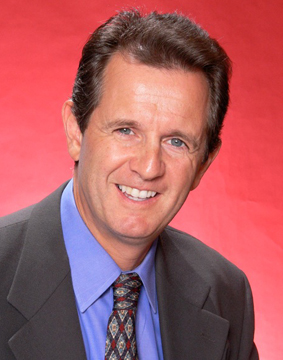 Let’s say you’ve been teaching for years. You’re well regarded among parents, students, teachers, and administrators. No one complains about you because you produce results— students consistently engaged and learning.
Let’s say you’ve been teaching for years. You’re well regarded among parents, students, teachers, and administrators. No one complains about you because you produce results— students consistently engaged and learning.
You’ve heard of rubber rooms, teacher jail, and housed teachers. You’ve seen YouTube videos where students openly talk about how easy it is to get a teacher fired. Students you respect have shared with you that they know there won’t be any consequences for them if they make false allegations against a teacher.
One day you’re informed that you are no longer to report to school. Why? You are told that you will later be provided the reason. But not right now. You’ve always been someone who follows the rules, and you know this mixup will be resolved in a few days. You report to an off-campus location, where other “housed” teachers are.
You learn about the three-step dismissal process. First you will have a Skelly hearing, a process where, by law, a supposedly neutral party informs you of the charges and makes a recommendation to the School Board. Yet you are told that these hearings are perfunctory—the Skelly officer is the exact opposite of neutral and with rare exception always recommends dismissal. After that, your case will be referred to the School Board. You won’t even be afforded the mere courtesy of addressing the board, even for two minutes, despite your years of service to the District’s students, and the Board will, with near certainty, vote to fire you. At that point you will be placed on unpaid leave, and your case will be referred to the Commission on Professional Competence, where a supposedly neutral three-person panel will decide whether you should be reinstated. Even if the CPC votes to reinstate, LAUSD can appeal, and either way, at this point it is unlikely you will ever return to the classroom. If the CPC upholds the decision, your case will be referred to the California Commission on Teacher Credentialing, which will move to revoke your credential.
Whenever UTLA raises concerns about housed teachers, individually or collectively, our arguments, no matter how sound, are often met with silence. As but one small example, we’ve told the District we need to be notified when a teacher is housed. The District’s response is that the teacher may not want UTLA to be involved, and were District officials to provide notification, they would be violating the teacher’s confidentiality. The District only recently provided a list of the number of housed teachers per area.
District leadership has staff who are paid for with private foundation grants. Most of the children of these foundation leaders attend the very best private schools, affording every possible opportunity money and privilege can buy: small class sizes; plenty of nurses, counselors, librarians, psychiatric social workers, pupil service and attendance counselors, and other health and human services professionals; strong early childhood, arts and adult education programs; healthy food; clean, safe, fully staffed campuses; and the fostering of an environment where discipline issues are addressed in a serious manner and where teachers are respected and celebrated.
Yet, oddly, the focus of these foundation leaders isn’t on working to provide even a fraction of these same rich services to public school students. Their agenda instead is “teacher effectiveness,” which is merely code for efforts to eliminate seniority and due process rights.
Propelled by this private foundation money, District leadership and several School Board members have lobbied state and national legislators to gut seniority laws and have been trying to overwhelm UTLA with cases to defend.
You finally find out the allegations against you—the charges are vague at best, and the criminal investigation never even got started because there wasn’t even a hint of any substantiated evidence. Yet the District is refusing to allow you to return to the classroom.
You could sue for wrongful termination or age discrimination, but you know the District would drag the case on for years, and the legal costs alone would surely bankrupt you, never mind the effect a prolonged lawsuit would have on your health and that of your family.
You turn on the TV and see LAUSD Superintendent John Deasy state, “When an individual is accused of an egregious act like molesting a child or being arrested for prostitution, then they are housed while there’s an investigation.”
You protest aloud that when an individual is accused of an egregious act, that individual is not housed—that individual is arrested, jailed, charged, and criminally prosecuted. That’s why we have a criminal justice system, to responsibly address how to respond to outrageous acts against humanity, which is as it should be. You resent being lumped into such a category, and in such an incredibly misleading manner.
AB 1530 (Alex Padilla (D) Pacoima) was a bill introduced last year that sought to place the entire dismissal process in the hands of school boards. Even the L.A. Times—which usually doesn’t agree with UTLA on anything—opposed it, writing that the bill “goes too far.” (Padilla has now reintroduced the bill as SB 10.) Last November, after Assembly member Betsy Butler didn’t support the bill, she was viciously attacked in election mailers and even attacked in a very unbalanced “report” on national TV by CNN’s Anderson Cooper. In the March 6 school board election, Monica Garcia’s own campaign (her actual campaign and not an independent expenditure) sent out a mailer with the headline, “Her opponents stand up for predators.” Sadly, in both campaigns, the attacks worked: Betsy Butler was not reelected, and Garcia won reelection.
UTLA is fighting back on several fronts. We’ve set up a task force and are developing a toolkit so housed teachers will have a sense of what to do and what not to do when targeted by District leadership. We’re developing our own ever-changing list of housed teachers, so we can better communicate with and advocate for their rights (that list has been compiled without the help of LAUSD leadership). We’re also actively consulting with counsel to formulate a legal strategy to help stem the bloodletting of experienced, veteran, competent teachers who are, each and every day, continuing to have their livelihoods destroyed.
Are students well served when the witch hunt against teachers is perpetuated at the direct expense of real-life advocacy efforts to increase funding, lower class size, and provide even a tenth of a fraction of the same opportunities for public school students that the children of billionaires enjoy?
Teachers welcome responsibility, and that duty extends not just to teachers but to parents, students, and administrators as well. Why is it that what’s good enough for the children of billionaires isn’t good enough for all students?
Community garden still going strong after five years
The music was blaring as residents walked the street fair on Raymond Avenue in South Los Angeles, on Saturday, to celebrate the saving of its community garden by the Los Angeles Neighborhood Land Trust and philanthropist Erika Glazer, along with the City and County of Los Angeles.
 Erika J. Glazer Community Garden (Photo by Subrina Hudson)
Erika J. Glazer Community Garden (Photo by Subrina Hudson)A ceremony was held to announce the renaming of the the Raymond Avenue Community Garden to Erika J. Glazer Community Garden, and to unveil a new sign for the Glazer Garden, which was designed by its founder, resident Julie Burleigh.
Booths were set up along the street around the DJ for residents to receive information about everything from conserving water to making a worm compost.
Children lined up eager to get their face-painted, and many had their hand cupped around small, makeshift pot made out of newspaper.
“I planted beans,” said Melissa Ramirez.
The eight-year-old scooped dirt into her pot and planted her seeds, right before spraying some water on top of the fresh dirt.
 Melissa Ramirez (Photo by Subrina Hudson)
Melissa Ramirez (Photo by Subrina Hudson)Nkoli Udeorji, a volunteer with the grass-roots organization LA Green Grounds, stood behind a table to show other kids how to plant their seed of choice. She said being at the event is a great way to connect with the community.
“I thought we would bring the kids and let them run around,” said Karlyn Johnson, who heard about the event from another parent.
Johnson lives just a few blocks away from Raymond Avenue and said she had never known there was a garden so close to her residence.
“The more we can do stuff [like this] the more we can help the neighborhood,” said Johnson.
Julie Burleigh, who has lived in the neighborhood for 11 years, started the garden in 2008 out of a desire to be more involved in her community and create a space for growing food.
Inside, there are 35, squared-off plots. A total of 24 families grow their own food and plants, with some owning multiple pots.
Demand is high for a chance to own a plot said Burleigh, as she points to a waiting list on a table outside of the garden’s entrance. She said right now the garden is only available to the community gardeners, but she is looking to open it up for the whole community in the future.
Almost three years ago, Burleigh reached out for help to the Los Angeles Neighborhood Land Trust (LANLT), an organization that helps underserved communities develop and manage small parks and community gardens.
The 5,000 square-foot space that was being maintained by community gardeners was at risk of being taken away. The property owner owed $100,000 in back taxes, but LANLT was able to step in and also find philanthropist Erika Glazer.
Glazer donated $150,000 to pay off the taxes as well as upgrades to the garden.
Burleigh said she is surprised that the community garden has been able to survive.
“I’m also so surprised that an organization an come in and save it. It’s hard to manage a community garden – more failures than success,” she said. “It’s amazing…a total dream come true.”
“It’s a great way to be a part of the community and to get to know people and connect with people everyday,” said Burleigh.
Crenshaw Digital Media Team develops an app for healthy eating
By Kevin Rivera
Crenshaw High School Senior
Going Banana’s for Health is the first game developed and designed by Mother Of Many’s Crenshaw High School Digital Media & Garden Team. Our digital media instructor, Ms. Daphne Bradford, the founder and CEO of Mother Of Many, opened the Windows 8 gaming opportunity for us when she was recognized by Microsoft as one the top innovative educators in the nation. Going Banana’s for Health was inspired by our Change What You Eat, Change How You Feel! healthy eating program supporting First Lady Michelle Obama’s Let’s Move! Initiative. Team members Esaul Parra, Kevin Rivera and Domonic Wilks developed the app.

The purpose of Going Banana’s for Health is to encourage adolescents to change their eating habits by making healthier choices. The game has three levels. The goal of each level is to drop Apple Dapple into Little Johnny’s mouth to avoid the danger of Little Johnny from being fed awful, unhealthy hot chips that most kids love. Each time you advance from level 1 to level 3, Little Johnny gets healthier if Apple Dapple makes it into his mouth.
The Level 1 challenge is to have Apple Dapple go jump through some platforms and eliminate the threat of the hot chips. As Apple Dapple jumps from various platforms, the player racks up points for destroying a bag by shooting Apple Dapple seeds at the bag of hot chips.
The game gets faster at Level 2. The goal is to rapidly get rid of the hot chips at a fast pace. The focus of this level is to jump on platforms as they move at different speeds. While that’s happening, you have to destroy the hot chips moving along the platforms by shooting Apple Dapple seeds. In doing so, the player can easily obtain a high score for jumping through these platforms in hopes of not falling off.
Level 3 is all about avoiding the vending machine dropping hot chips. The chips are dispensed from a vending machine-like box right next to Little Johnny. In order to reach him, Apple Dapple has to destroy all the hot chips sliding down a ramp towards him. After the player destroys the hot chips, Apple Dapple can go up the ramp without any threat and feed Little Johnny.
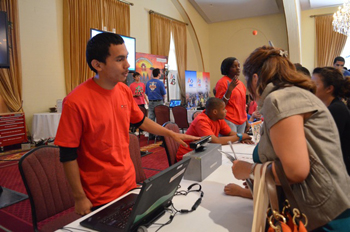 Author Kevin Rivera, one of the developers of the Crenshaw Digital Media Team’s healthy eating app. Author Kevin Rivera, one of the developers of the Crenshaw Digital Media Team’s healthy eating app. |
When Apple Dapple eliminates the hot chips then it shows an example of how adolescence can choose to get rid of the junk food in their diet and go for the healthy alternative.
It was really fun programming Going Banana’s for Health. We used our Windows 7 laptop to make it for the Windows 8 App Store. This experience was like playing football without a football and still scoring a touchdown. Awesome!”
– Esaul Parra
“Who would’ve thought that I went from learning how to eat properly to making a game based off that? I actually made my first game with my Crenshaw high school peers for the Windows 8 App store. People like my peers and I are going to be the future.”
– Kevin Rivera
 Domonic Wilks and Kevin Rivera with Crenshaw High School teacher Jacqueline Lopez. Domonic Wilks and Kevin Rivera with Crenshaw High School teacher Jacqueline Lopez. |
Mother Of Many is launching a social media fundraising campaign in an effort to get a minimum of 1,000 people to donate $10 a month.
“Our grant with the California Endowment is coming to end and I’m hoping and praying M.O.M.’s Facebook and Twitter family and followers will give up one unhealthy meal or two Starbucks Coffees or Happy Hour drinks a month to support innovative education,” said Bradford.
If you would like to support Mother Of Many students visit www.MotherofMany and click the “Donate Now” button to make your $10.00 a month donation.
Protests against shutdown of some L.A. County Courthouses
By Nicolette Kelegian
Listen to an audio story from Annenberg Radio News
The Los Angeles Superior Court system will begin consolidating courthouses in order to close the budget deficit. Those facing small claim cases, particularly landlord-tenant disputes, will have to travel farther to attend their court date. Twenty-six courthouses will be consolidated into five starting March 18. Courts will be shut down in Huntington Park, Whittier, Pomona North, Malibu, West Los Angeles, San Pedro, Beacon St., and the Kenyon Juvenile Justice Street.
Union activists and community advocates held protests on Thursday outside the Los Angeles County Courthouse in Downtown LA.
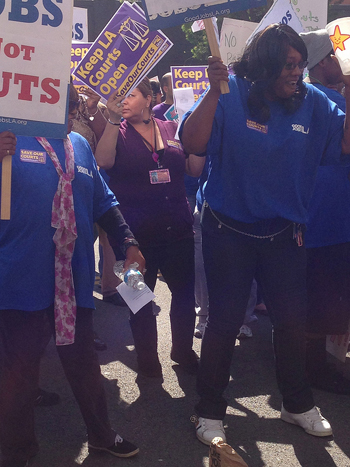 Legal aid groups are suing the Los Angeles County Courts saying the cuts will directly affect lower-income families and the disabled. Leonard Vilchis, from the organization Union de Vecinos, says these court closures will force people out of their homes. “This will be a tragedy for very low-income and for senior citizens who are trying to protect their housing because by not making it to the court they will lose their housing and end up homeless,” Vilchis said.
Legal aid groups are suing the Los Angeles County Courts saying the cuts will directly affect lower-income families and the disabled. Leonard Vilchis, from the organization Union de Vecinos, says these court closures will force people out of their homes. “This will be a tragedy for very low-income and for senior citizens who are trying to protect their housing because by not making it to the court they will lose their housing and end up homeless,” Vilchis said.
Barbara Shultz, an attorney with one of the law firms that filed the lawsuit, explains that these court closures create transportation barriers for low-income and disabled people.
“Our low-income tenants who live in Whiittier or Pico Rivera will have to be on a bus by 6 a.m. in order to reach the Long Beach Courthouse by 8:30 court call,” Shultz said.
Shultz fears that these closures will put power in the hands of landlords, who can take advantage of their tenants.
“Particularly those with disreputable landlords who will file dubious evictions knowing that the likelihood of tenants being able to make it to a courthouse more than 30 miles away on multiple buses is iffy at best,” Shultz said.
If a tenant doesn’t show up to the hearing, a default judgment results. In other words, the judgment is in favor of the plaintiff, or landlord because the defendant failed to appear at the meeting.
Not only will it be challenging for low-income and disabled tenants to make it their court date, but these court closures will affect kids in the juvenile system.
Leon Brown is the outreach supervisor for the organization, People for Community Involvement. “If there not in court on time and what not they issue bench warrants and that’s another cycle of the juveniles being in the system and it will carry on into their adulthood,” Brown said.
Court documents say there will be no more financial reserves at the end of this fiscal year and that the only way to balance its budget is to operate fewer courthouses and change the caseloads of other courtrooms in order to cut back on staff.
James Upshaw, a Los Angeles resident and member of the organization “Good Jobs L.A.,” fears that these court foreclosures will take away the community’s voice.
“The residents of Los Angeles will not have a voice. We can cry loud in our community. We can cry loud in our town hall meetings. I feel we’re not clearly heard until we’re heard by the courts.”














